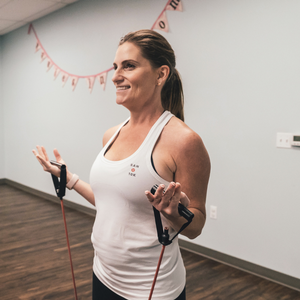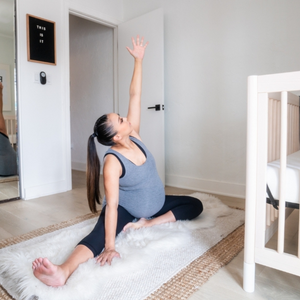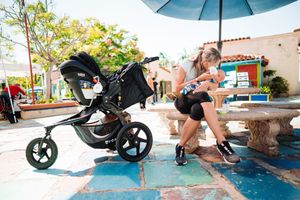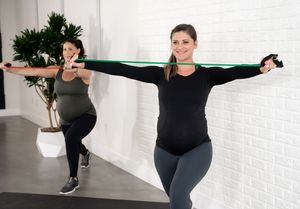
Training By Trimester: 2nd Trimester
FIT4MOM x Jessica Maurer
Fondly referred to as the golden trimester, the 2nd Trimester is usually when a pregnant woman starts to feel her best and has more energy! Morning sickness and fatigue tend to dissipate in weeks 18-20 for most pregnant women (hallelujah!).
If you are in your 2nd Trimester, you should start or continue to move your body regularly. This is particularly important as sleep disturbances can become more prevalent, and regular exercise can help control or reduce these disruptions. Your breasts are growing, altering the center of gravity and possibly impacting your spinal alignment. You can help reduce this imbalance by working strengthening and mobility exercises for your core into your exercise routine. Also, the hormone progesterone can cause stomach upset, like gas or heartburn. Consistent exercise can help with food motility, too, which decreases the time food stays in the stomach and small intestine.
During the 2nd Trimester, the uterus size increases rapidly to accommodate your growing fetus. Accompanying this rapid growth, pregnancy becomes more uncomfortable as your body makes room for the growing uterus, and the muscles and supporting pelvic structures are stretched. By the end of the 2nd Trimester, the fetus grows to almost four times the size it was at the end of the 1st Trimester.
Many pregnant women may not feel like exercising during the 1st Trimester. It is safe to start a regular exercise or workout routine in the 2nd Trimester, even if you did not participate in one during the 1st Trimester. Even if you are starting an exercise program in your 2nd Trimester, the benefits both during the pregnancy and postpartum can be tremendous!
In addition to the typical weight gain of the 2nd Trimester, a woman’s biomechanics will begin to shift. You will need time to adapt to these changes in their center of gravity, adjustments in gait, increased size, and potential issues with balance.
Just as we advocated throughout the 1st Trimester, we want to encourage you to continue moving throughout the 2nd Trimester. Let's dive into our Start, Stop, and Continue for fitness in the 2nd Trimester.
START
Low back pain is common for many pregnant women. As you gain weight, your center of gravity changes. Not to mention, the hormone relaxin relaxes the ligaments in the joints of your pelvis and all the joints of your body. To avoid falling forward, you will compensate by leaning back, which can strain the muscles in the lower back and contribute to back pain during pregnancy (fun, right?). To alleviate some of these ailments, start strengthening your posterior chain with pulling exercises and fully training your core with multiple positions, power players, and purposes!
How can you start core training? Check out these core safe exercises for all moms.
STOP
Stop using equipment that you may trip over. As your belly grows, you will lose sight of the floor. Your balance, coordination, and reaction times will also suffer as your joints swell. To stay safe, stand beside the equipment. This is also why we want you to slow down when moving laterally. Be cautious when including exercises where you may move quickly to the side, which could cause sprains or falls.
At this time, lying fully prone on the ground will likely be uncomfortable. Elevate yourself to quadruped (hands and knees) or standing for typical laying-prone exercises.
CONTINUE
Finally, and most importantly, continue to move! You still need to do a daily body scan to see how you're feeling, as we reviewed in the 1st Trimester blog. You may need to adjust your intensity to enjoy every exercise. If you are feeling more energized, getting more rest, and staying hydrated, the workload and intensity can be increased as long as the activity continues to create more energy and allows for pain-free ranges of motion.
If you want to continue with high or mid-impact options, you may. However, at this time, you may not want to continue those exercises or modalities. As your pelvic floor stretches, it will weaken and cause discomfort during higher-impact exercises. So, while you can continue with higher-impact movements, you may choose NOT to.
In the 2nd Trimester, you may also want to stay at a lower impact option due to your joint instability. Relaxin will increase joint flexibility and potential joint instability, particularly in the pelvis, knees, and ankles. This instability can have implications for landing high-impact movements and overall exercise routines. The increased flexibility of the pelvic ligaments can affect the alignment of the pelvis itself, potentially causing shifts in posture and movement mechanics. When engaging in high-impact activities that involve jumping, running, or rapid movements, the joints—particularly the knees and ankles—may not receive the same level of support from the stabilizing ligaments, muscles, and connective tissues. This lack of stability can lead to a compromised ability to effectively absorb the impact of these movements, increasing the risk of strain or injury.
The instability of the pelvic girdle can also impact the function of the pelvic floor muscles. The pelvic floor plays a vital role in supporting the organs of the pelvis and maintaining continence. The changes in pelvic alignment and the potential strain on the pelvic floor during high-impact movements can contribute to issues such as pelvic floor dysfunction, urinary incontinence, or discomfort. While there isn't a specific numerical value that indicates the exact amount of force the pelvic floor can handle, it's important to note that the pelvic floor can become compromised under excessive or repetitive strain. This is particularly relevant during activities that increase intra-abdominal pressure, such as heavy lifting, intense straining, or high-impact movements like jumping or running.
Considering these factors, please be cautious and selective when participating in high-impact activities. Engaging in controlled exercises that prioritize stability, proper alignment, and controlled movements can help reduce the risk of strain, discomfort, and potential injuries. The decision to continue high-impact exercises should be based on your health, fitness level, pregnancy complications, and how your body responds.
Can you continue your impact activities like running and jumping while pregnant? Yes. Ultimately, you can continue or you can modify impact activities using variables as shared in the blog “5 Ways to Boost Your Workout & Mood”.
Do you want more information and guidance? Motherhood is a transformative journey filled with joy, challenges, and the need for incredible strength. Since 2001, FIT4MOM has been the leader of prenatal and postnatal fitness, supporting moms nationwide through our network of franchise owners and dedicated instructors. To further support our mission of helping all moms find their Strength in Motherhood®, we are thrilled to announce our first-ever certification course available to all fitness professionals: FIT4MOM’s Prenatal & Postnatal Fitness Certification.
Let's empower moms to find their Strength in Motherhood® and unlock their full potential for everyday life as a new parent. Motherhood is an extraordinary experience; with FIT4MOM, you can make it even more empowering for your clients.
WANT TO LEARN MORE?
Bringing new life into the world is a miraculous and life-altering experience, but it's no secret that pregnancy and postpartum can bring a whirlwind of changes to a woman's body. As a fitness professional or health enthusiast, you have the power to support and empower mothers on their journey to a healthy pregnancy, a smoother birth experience, and a robust postpartum recovery.
Register here to receive more information for training the female client.
WANT MORE, MAMA?
Other blogs about pregnancy you'll enjoy:





